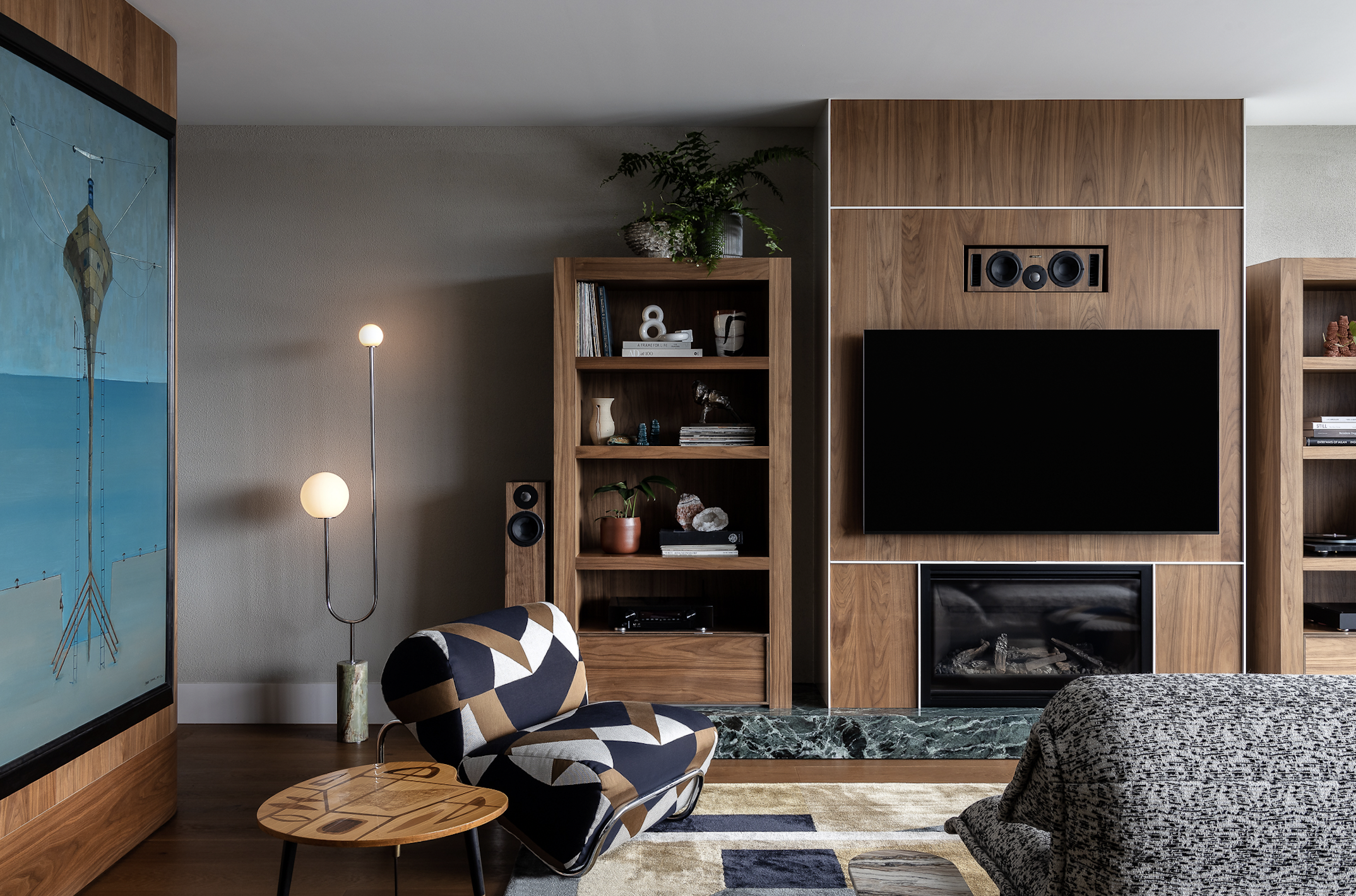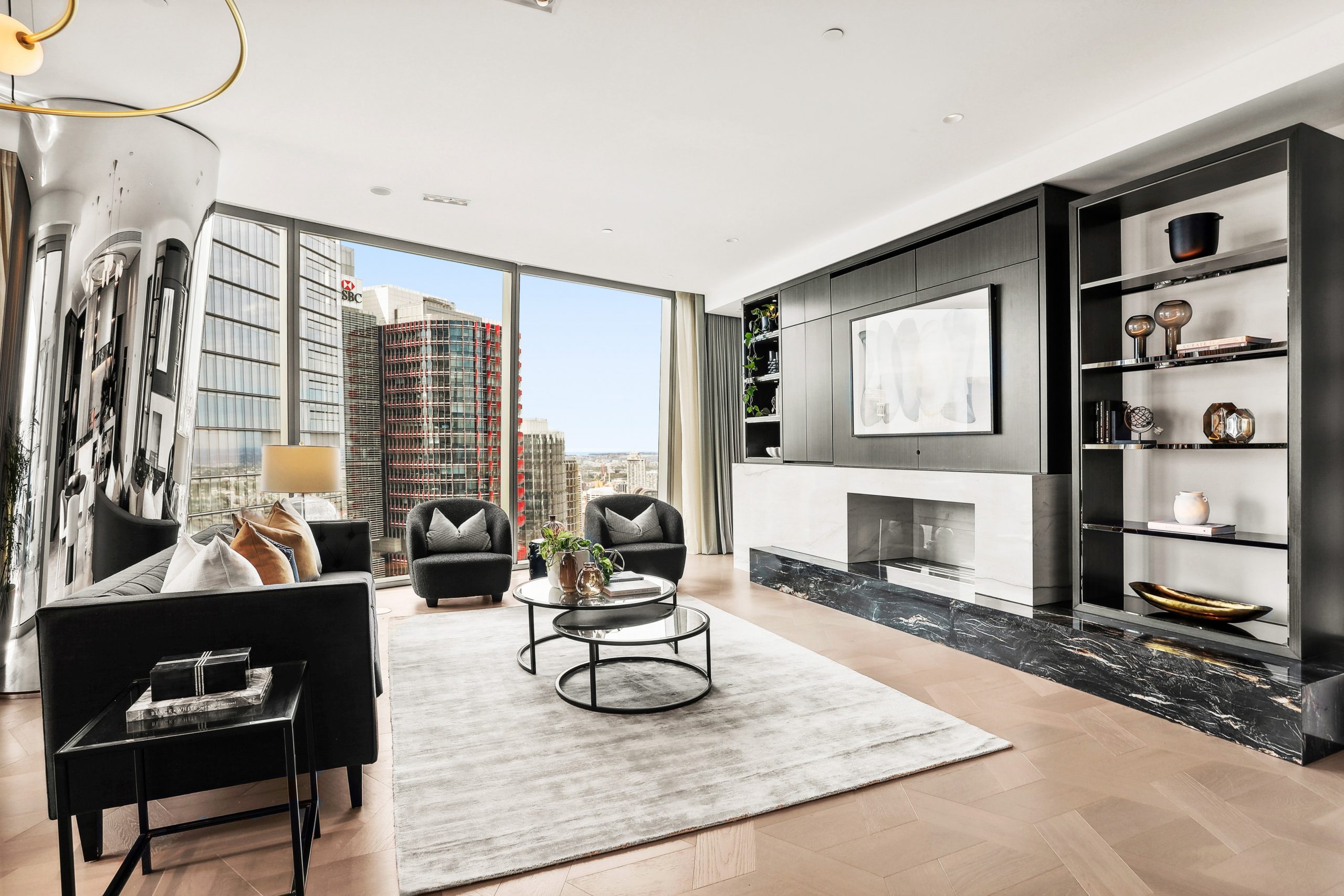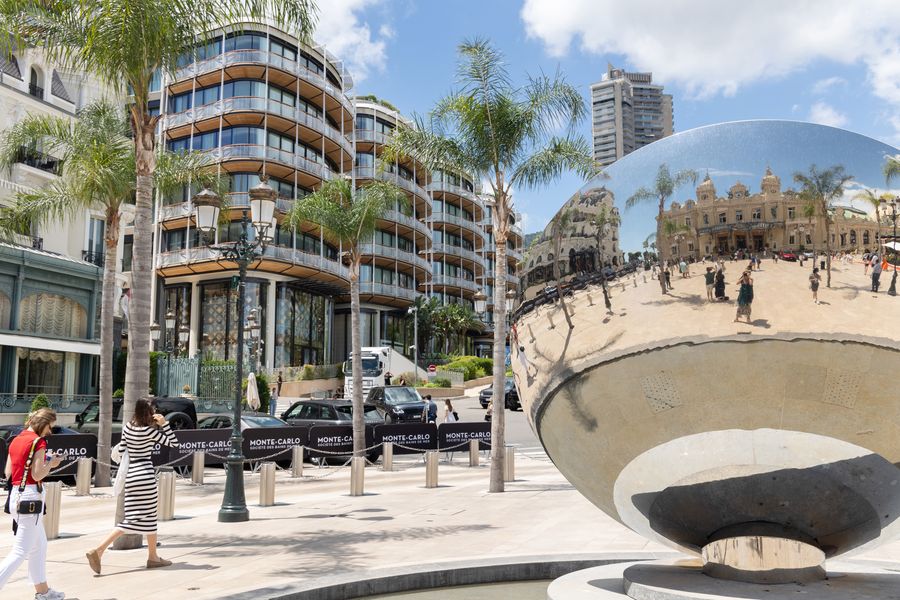The secret weapon for selling prestige property
Developers, architects and agents are turning to contemporary Australian art to make their properties stand out from the crowd
When architect Phillip Mathieson first walked members of Third.i property group through the interiors he had designed for their Kurraba Point “super penthouse”, there were a few raised eyebrows. It wasn’t the million-dollar kit-out of furniture and decor by French luxury brand Liaigre that was disconcerting his clients — it was the art. Not the Brett Whiteley linocut of a dove, or the intricately patterned larrakitj (memorial pole) by Yolngu artist Malaluba Gumana, but the yellow mirrored work by young queer artist Tay Haggarty, which appeared to be pinioned to the wall by four white socks.
Find more stories like this in the latest issue of Kanebridge Quarterly magazine, Australia’s best resource for property, money and living. Order your copy here.
Mathieson, whose architecture firm was charged with the interiors for all 24 residences in Third.i’s new Sydney Harbour-side development (including 21 harbourfront apartments and two sub-penthouses), was given free rein on choosing the art for the penthouses, and engaged the expertise of Artbank: a governmental body whose collection of more than 10,000 Australian artworks spans from the 1920s to now, all available to lease. In the super-penthouse, the selection includes a monumental work in black Belgian marble by the late Melbourne artist Joel Elenberg (who smashed the sales record for Australian sculpture in August 2023 with a similar work, which sold for $925,000) and a mix of abstract and figurative works by significant artists such as Bronwyn Oliver and Marion Borgelt.
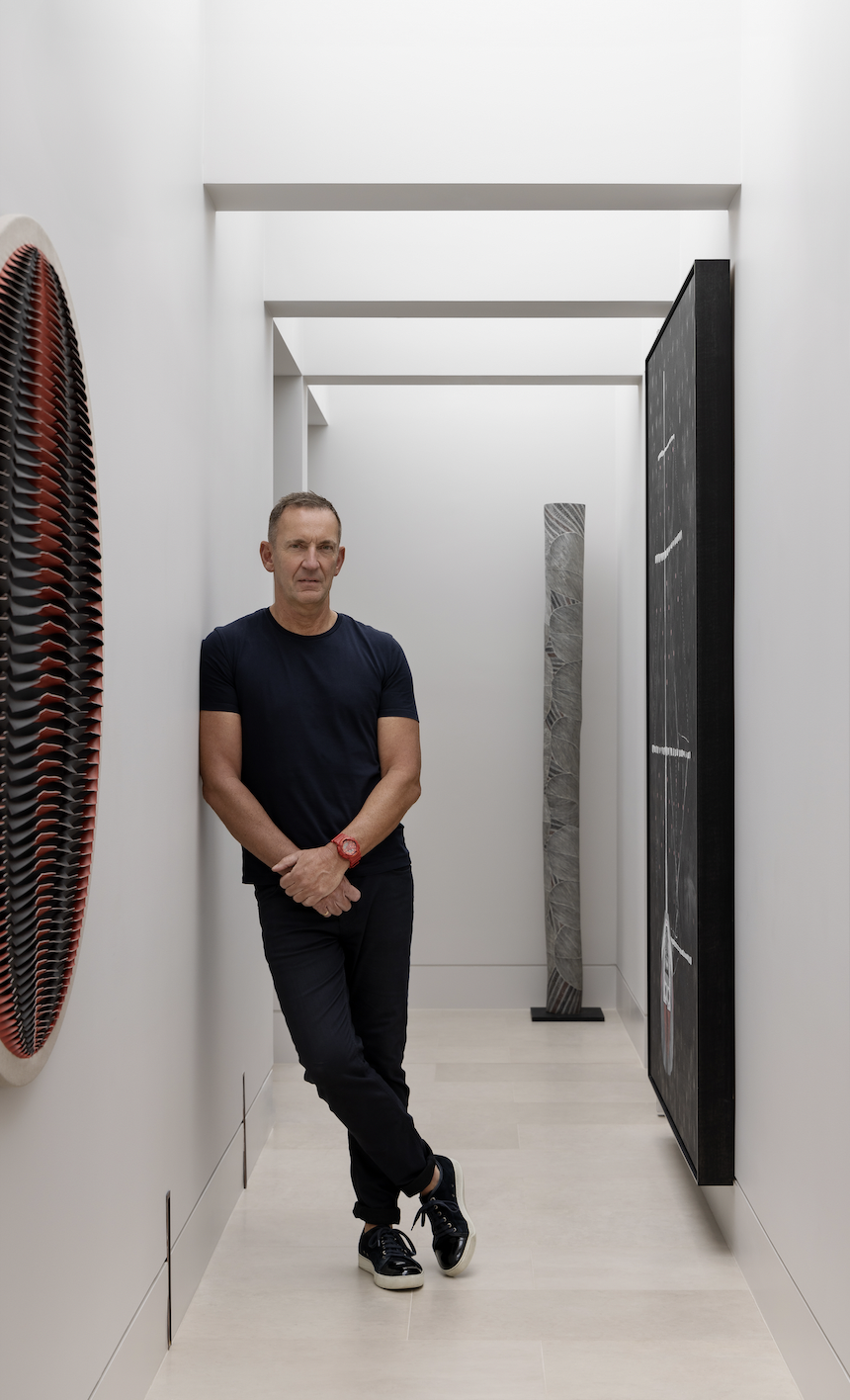
Amongst these, Haggarty’s piece stands out: “It’s quite a controversial piece to have in there, given that it’s a very high end development,” says Artbank consultant Carey Corbett, who worked closely with Mathieson Architects to select the works. “I imagine the expected clientele is not so familiar with their work, being a younger artist — and possibly not the sort of artist that some of those prospective buyers would have in their homes.”
But Haggarty’s piece, titled Sun on Bare Back, provides a moment of delicious, cheeky dissonance within the elegant surroundings.
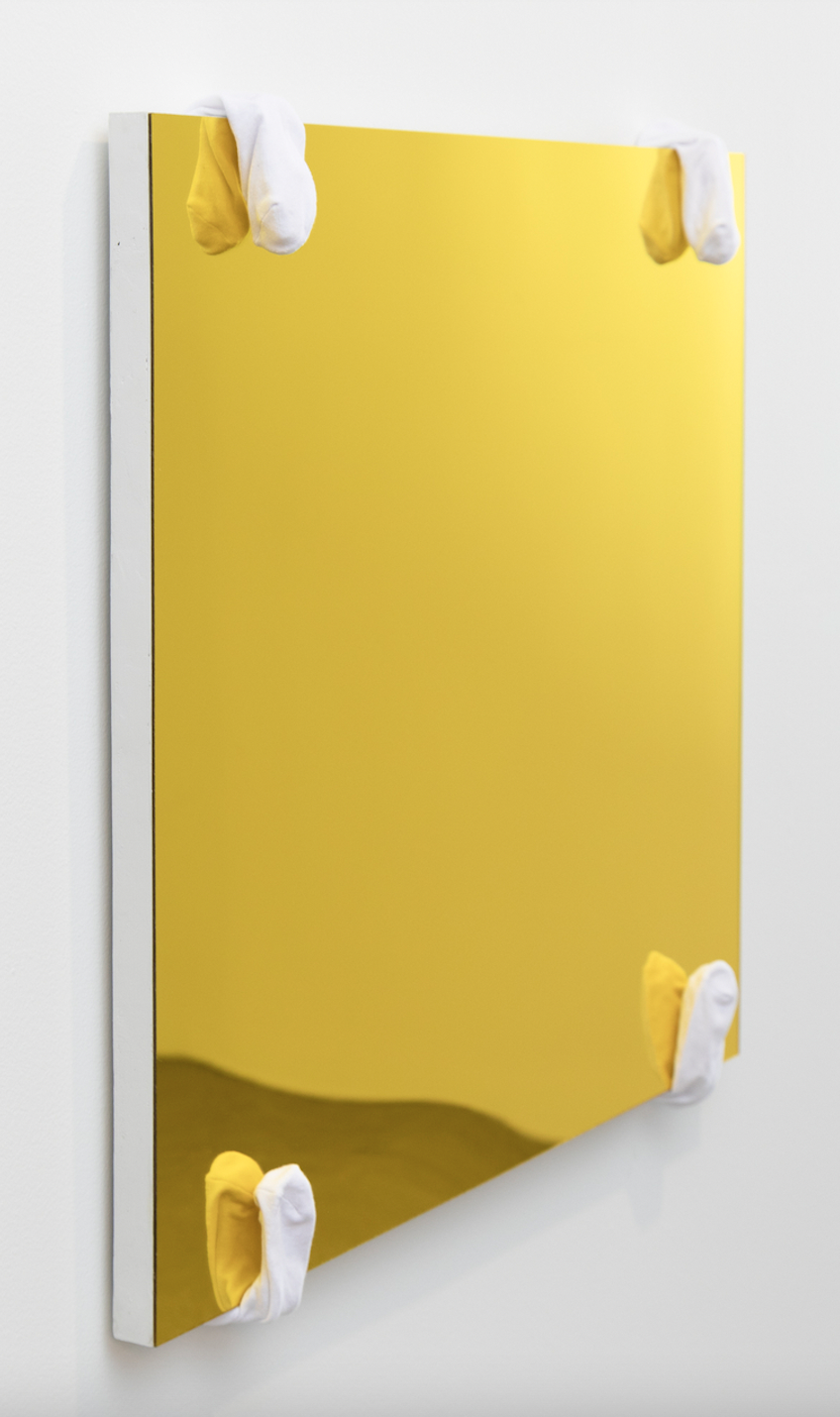
It’s the kind of memorable moment designed to cut through at the top end of the market.
As Mathieson says: “Quite often what happens when there’s a display suite for a project, or even when a project is finished, either it’s left empty or it’s furnished with rental items, and you end up with a bad reproduction poster on the wall; it’s all very generic. The Kurraba project was unusual in that the developer, I think partly because of the market that they were going after and the calibre of the location and the apartment itself, saw the value in buying furniture -— and therefore the natural extension of that was to fully provide the experience of how someone might live.
“The art is part of that.”
Lachie Gibson, founder and CEO of Melbourne developer ANGLE, agrees. His outfit prides itself on providing a holistic package of high quality location, architecture, landscape and interiors — and he sees art as a “crucially important” extension of that. ANGLE champions Australian creatives, partnering with emerging talent (including furniture designer Thomas Lentini, before he broke into the big league) and local heroes such as Dinosaur Designs, design firm Flack Studio, commercial galleries and Artbank, to create distinctive interiors for their high-end residential developments, including the multi-award-winning Fenwick, in Kew.
“We’ve had success over the years selling off the plan, but at the end of a project you might have a $6 million penthouse [not yet sold] and so you’re styling it for sale — and the difference between the kind of generic property stylist that the real estate companies use and partnering with someone like Artbank, is huge,” Gibson says.
Even when apartments are sold off the plan, ANGLE typically brokers relationships between buyers and interior designers, who will then do a full furniture and art fit out. “Obviously it’s awesome for the client — it elevates their space and makes it feel incredible. But also for us as a developer, the photographs of those completed spaces become almost our number one marketing tool,” Gibson says.
“It’s pretty easy to go and render something up, but having a built space that’s got amazing artwork is hugely advantageous to us.”
For their latest development, Fenhurst, ANGLE is partnering with Artbank to select hero pieces for the common areas, and with Melbourne gallery Daine Singer for apartment artworks — which will be shown in marketing renders, but available to see in the flesh (and purchase) from the developer’s Harold Street Gallery: a multi-purpose space in Camberwell that was designed by Fleur Sutherland and showcases ANGLE’s regular collaborators alongside a rotating selection of pieces from Artbank and Craft Victoria.
It’s not just developers harnessing art for a competitive edge. When Simon Hakim, CEO of creative agency Hunter, and his wife decided to put their stunning home “Rail House” in Melbourne’s Northcote on the market, they knew they needed art for the massive walls in their central living area.
“Over the years, we’d been talking about putting artwork up there, and had a built-in rail installed specifically for art [but] we couldn’t ever decide on what we liked,” he says. Then a neighbour introduced Hakim to Artbank, which has short and long-term and annual leasing plans that range from $165 to $5500 per annum.
“It was a really good way to test out the art wall — and to see massive works that we were able to display [on the rail] but couldn’t afford,” Hakim says.
In the end, they leased a series of prints by photographer Bill Henson.
“It filled an empty void; it made a huge impact on the house. [And] we had a lot of comments about the work [from prospective buyers],” says Hakim.
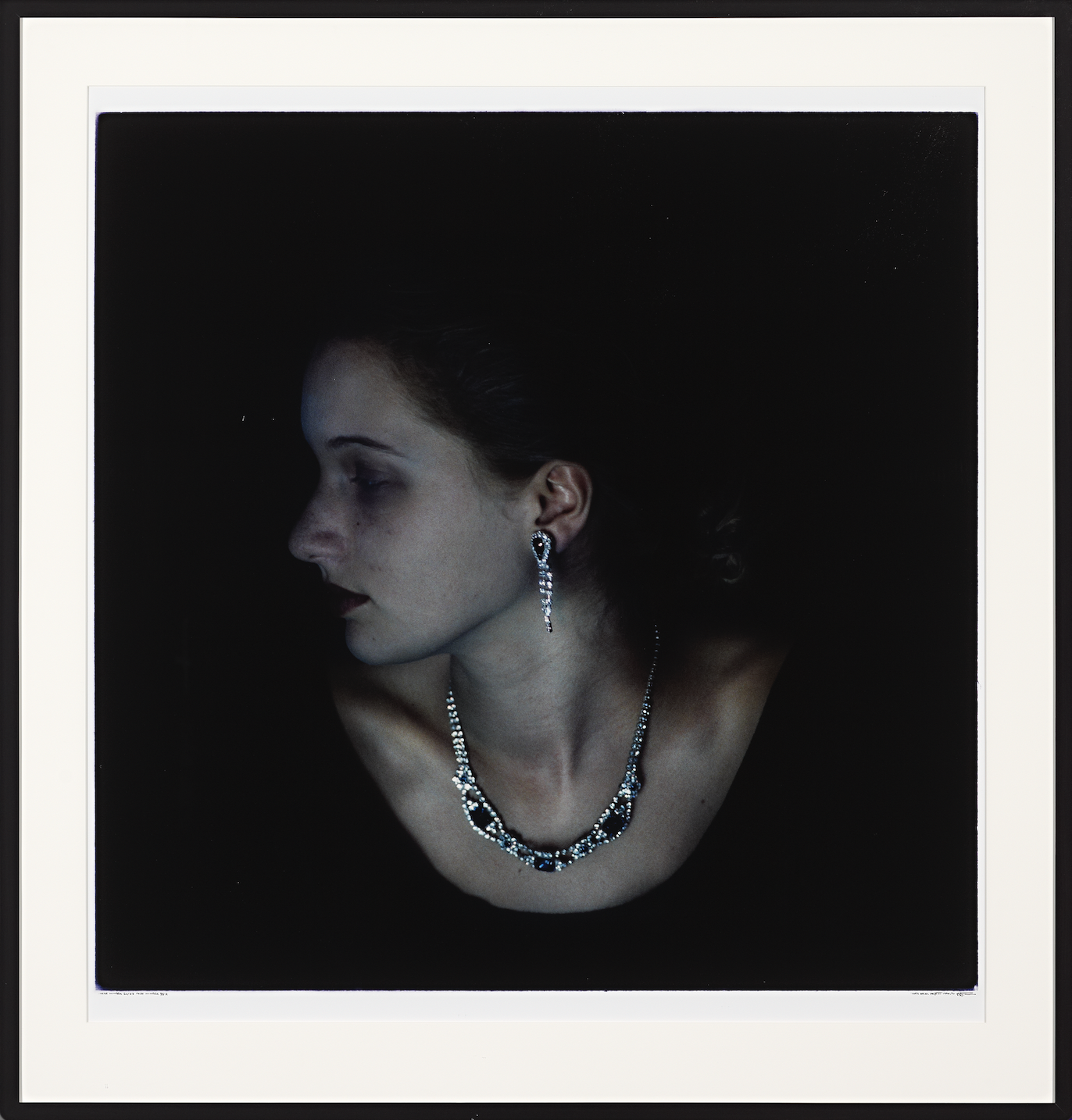
Sydney property agent Georgia Cleary, of McGrath Paddington, says there’s an increased appreciation of art across the market these days, and in the prestige end of the market in particular: “People will pay tens of thousands of dollars to style their properties, and you can’t put prints into those homes.”
McGrath generally asks stylists not to put art on the walls, and instead partners with local artists and galleries to select high-end pieces. “We’ve found that the market responds really well to original works [rather than reproductions or prints],” says Cleary. “It elevates the perception of the property as ‘prestige’.”
This stylish family home combines a classic palette and finishes with a flexible floorplan
Just 55 minutes from Sydney, make this your creative getaway located in the majestic Hawkesbury region.
Ahead of the Games, a breakdown of the city’s most desirable places to live
PARIS —Paris has long been a byword for luxurious living. The traditional components of the upscale home, from parquet floors to elaborate moldings, have their origins here. Yet settling down in just the right address in this low-rise, high-density city may be the greatest luxury of all.
Tradition reigns supreme in Paris real estate, where certain conditions seem set in stone—the western half of the city, on either side of the Seine, has long been more expensive than the east. But in the fashion world’s capital, parts of the housing market are also subject to shifting fads. In the trendy, hilly northeast, a roving cool factor can send prices in this year’s hip neighborhood rising, while last year’s might seem like a sudden bargain.
This week, with the opening of the Olympic Games and the eyes of the world turned toward Paris, The Wall Street Journal looks at the most expensive and desirable areas in the City of Light.
The Most Expensive Arrondissement: the 6th
Known for historic architecture, elegant apartment houses and bohemian street cred, the 6th Arrondissement is Paris’s answer to Manhattan’s West Village. Like its New York counterpart, the 6th’s starving-artist days are long behind it. But the charm that first wooed notable residents like Gertrude Stein and Jean-Paul Sartre is still largely intact, attracting high-minded tourists and deep-pocketed homeowners who can afford its once-edgy, now serene atmosphere.
Le Breton George V Notaires, a Paris notary with an international clientele, says the 6th consistently holds the title of most expensive arrondissement among Paris’s 20 administrative districts, and 2023 was no exception. Last year, average home prices reached $1,428 a square foot—almost 30% higher than the Paris average of $1,100 a square foot.
According to Meilleurs Agents, the Paris real estate appraisal company, the 6th is also home to three of the city’s five most expensive streets. Rue de Furstemberg, a secluded loop between Boulevard Saint-Germain and the Seine, comes in on top, with average prices of $2,454 a square foot as of March 2024.
For more than two decades, Kyle Branum, a 51-year-old attorney, and Kimberly Branum, a 60-year-old retired CEO, have been regular visitors to Paris, opting for apartment rentals and ultimately an ownership interest in an apartment in the city’s 7th Arrondissement, a sedate Left Bank district known for its discreet atmosphere and plutocratic residents.
“The 7th was the only place we stayed,” says Kimberly, “but we spent most of our time in the 6th.”
In 2022, inspired by the strength of the dollar, the Branums decided to fulfil a longstanding dream of buying in Paris. Working with Paris Property Group, they opted for a 1,465-square-foot, three-bedroom in a building dating to the 17th century on a side street in the 6th Arrondissement. They paid $2.7 million for the unit and then spent just over $1 million on the renovation, working with Franco-American visual artist Monte Laster, who also does interiors.
The couple, who live in Santa Barbara, Calif., plan to spend about three months a year in Paris, hosting children and grandchildren, and cooking after forays to local food markets. Their new kitchen, which includes a French stove from luxury appliance brand Lacanche, is Kimberly’s favourite room, she says.
Another American, investor Ashley Maddox, 49, is also considering relocating.
In 2012, the longtime Paris resident bought a dingy, overstuffed 1,765-square-foot apartment in the 6th and started from scratch. She paid $2.5 million and undertook a gut renovation and building improvements for about $800,000. A centrepiece of the home now is the one-time salon, which was turned into an open-plan kitchen and dining area where Maddox and her three children tend to hang out, American-style. Just outside her door are some of the city’s best-known bakeries and cheesemongers, and she is a short walk from the Jardin du Luxembourg, the Left Bank’s premier green space.
“A lot of the majesty of the city is accessible from here,” she says. “It’s so central, it’s bananas.” Now that two of her children are going away to school, she has listed the four-bedroom apartment with Varenne for $5 million.
The Most Expensive Neighbourhoods: Notre-Dame and Invalides
Garrow Kedigian is moving up in the world of Parisian real estate by heading south of the Seine.
During the pandemic, the Canada-born, New York-based interior designer reassessed his life, he says, and decided “I’m not going to wait any longer to have a pied-à-terre in Paris.”
He originally selected a 1,130-square-foot one-bedroom in the trendy 9th Arrondissement, an up-and-coming Right Bank district just below Montmartre. But he soon realised it was too small for his extended stays, not to mention hosting guests from out of town.
After paying about $1.6 million in 2022 and then investing about $55,000 in new decor, he put the unit up for sale in early 2024 and went house-shopping a second time. He ended up in the Invalides quarter of the 7th Arrondissement in the shadow of one Paris’s signature monuments, the golden-domed Hôtel des Invalides, which dates to the 17th century and is fronted by a grand esplanade.
His new neighbourhood vies for Paris’s most expensive with the Notre-Dame quarter in the 4th Arrondissement, centred on a few islands in the Seine behind its namesake cathedral. According to Le Breton, home prices in the Notre-Dame neighbourhood were $1,818 a square foot in 2023, followed by $1,568 a square foot in Invalides.
After breaking even on his Right Bank one-bedroom, Kedigian paid $2.4 million for his new 1,450-square-foot two-bedroom in a late 19th-century building. It has southern exposures, rounded living-room windows and “gorgeous floors,” he says. Kedigian, who bought the new flat through Junot Fine Properties/Knight Frank, plans to spend up to $435,000 on a renovation that will involve restoring the original 12-foot ceiling height in many of the rooms, as well as rescuing the ceilings’ elaborate stucco detailing. He expects to finish in 2025.
Over in the Notre-Dame neighbourhood, Belles demeures de France/Christie’s recently sold a 2,370-square-foot, four-bedroom home for close to the asking price of about $8.6 million, or about $3,630 a square foot. Listing agent Marie-Hélène Lundgreen says this places the unit near the very top of Paris luxury real estate, where prime homes typically sell between $2,530 and $4,040 a square foot.
The Most Expensive Suburb: Neuilly-sur-Seine
The Boulevard Périphérique, the 22-mile ring road that surrounds Paris and its 20 arrondissements, was once a line in the sand for Parisians, who regarded the French capital’s numerous suburbs as something to drive through on their way to and from vacation. The past few decades have seen waves of gentrification beyond the city’s borders, upgrading humble or industrial districts to the north and east into prime residential areas. And it has turned Neuilly-sur-Seine, just northwest of the city, into a luxury compound of first resort.
In 2023, Neuilly’s average home price of $1,092 a square foot made the leafy, stately community Paris’s most expensive suburb.
Longtime residents, Alain and Michèle Bigio, decided this year is the right time to list their 7,730-square-foot, four-bedroom townhouse on a gated Neuilly street.
The couple, now in their mid 70s, completed the home in 1990, two years after they purchased a small parcel of garden from the owners next door for an undisclosed amount. Having relocated from a white-marble château outside Paris, the couple echoed their previous home by using white- and cream-coloured stone in the new four-story build. The Bigios, who will relocate just back over the border in the 16th Arrondissement, have listed the property with Emile Garcin Propriétés for $14.7 million.
The couple raised two adult children here and undertook upgrades in their empty-nester years—most recently, an indoor pool in the basement and a new elevator.
The cool, pale interiors give way to dark and sardonic images in the former staff’s quarters in the basement where Alain works on his hobby—surreal and satirical paintings, whose risqué content means that his wife prefers they stay downstairs. “I’m not a painter,” he says. “But I paint.”
The Trendiest Arrondissement: the 9th
French interior designer Julie Hamon is theatre royalty. Her grandfather was playwright Jean Anouilh, a giant of 20th-century French literature, and her sister is actress Gwendoline Hamon. The 52-year-old, who divides her time between Paris and the U.K., still remembers when the city’s 9th Arrondissement, where she and her husband bought their 1,885-square-foot duplex in 2017, was a place to have fun rather than put down roots. Now, the 9th is the place to do both.
The 9th, a largely 19th-century district, is Paris at its most urban. But what it lacks in parks and other green spaces, it makes up with nightlife and a bustling street life. Among Paris’s gentrifying districts, which have been transformed since 2000 from near-slums to the brink of luxury, the 9th has emerged as the clear winner. According to Le Breton, average 2023 home prices here were $1,062 a square foot, while its nearest competitors for the cool crown, the 10th and the 11th, have yet to break $1,011 a square foot.
A co-principal in the Bobo Design Studio, Hamon—whose gut renovation includes a dramatic skylight, a home cinema and air conditioning—still seems surprised at how far her arrondissement has come. “The 9th used to be well known for all the theatres, nightclubs and strip clubs,” she says. “But it was never a place where you wanted to live—now it’s the place to be.”
With their youngest child about to go to college, she and her husband, 52-year-old entrepreneur Guillaume Clignet, decided to list their Paris home for $3.45 million and live in London full-time. Propriétés Parisiennes/Sotheby’s is handling the listing, which has just gone into contract after about six months on the market.
The 9th’s music venues were a draw for 44-year-old American musician and piano dealer, Ronen Segev, who divides his time between Miami and a 1,725-square-foot, two-bedroom in the lower reaches of the arrondissement. Aided by Paris Property Group, Segev purchased the apartment at auction during the pandemic, sight unseen, for $1.69 million. He spent $270,000 on a renovation, knocking down a wall to make a larger salon suitable for home concerts.
During the Olympics, Segev is renting out the space for about $22,850 a week to attendees of the Games. Otherwise, he prefers longer-term sublets to visiting musicians for $32,700 a month.
Most Exclusive Address: Avenue Junot
Hidden in the hilly expanses of the 18th Arrondissement lies a legendary street that, for those in the know, is the city’s most exclusive address. Avenue Junot, a bucolic tree-lined lane, is a fairy-tale version of the city, separate from the gritty bustle that surrounds it.
Homes here rarely come up for sale, and, when they do, they tend to be off-market, or sold before they can be listed. Martine Kuperfis—whose Paris-based Junot Group real-estate company is named for the street—says the most expensive units here are penthouses with views over the whole of the city.
In 2021, her agency sold a 3,230-square-foot triplex apartment, with a 1,400-square-foot terrace, for $8.5 million. At about $2,630 a square foot, that is three times the current average price in the whole of the 18th.
Among its current Junot listings is a 1930s 1,220-square-foot townhouse on the avenue’s cobblestone extension, with an asking price of $2.8 million.
This stylish family home combines a classic palette and finishes with a flexible floorplan
Just 55 minutes from Sydney, make this your creative getaway located in the majestic Hawkesbury region.









